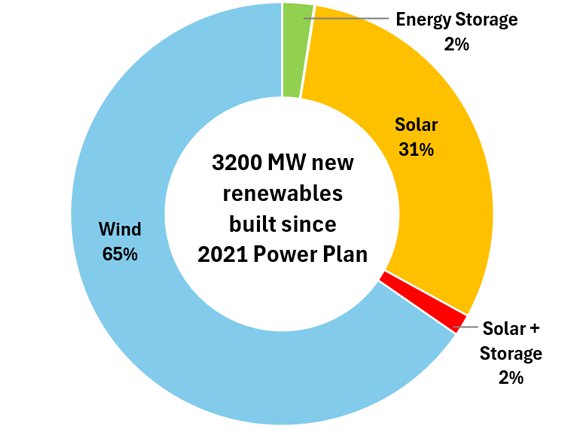Update on Generating Resources Development
- February 20, 2024
- Annika Roberts

At the February meeting in Coeur d’Alene Idaho, staff presented the Council with an update on generating resources built since the 2021 Power Plan (see presentation and video).
The 2021 Plan Resource Strategy called for the region to build at least 3,500 megawatts of renewable resources by 2027, though identified that jurisdictions pursuing ambitious decarbonization or electrification may need to build more. The region is already well on its way to achieving that goal, having built around 3,200 megawatts of new renewables since the plan.
The Council also tracks resources built in the broader West to provide insight on the plan's assumptions around west-wide build outs and how those inform market prices. WECC-wide, approximately 42,000 megawatts of new renewables have been built, which is notably less than the 115 Gigawatts the plan assumed would be built by 2024. This slower pace of renewable builds mitigates some of the region’s reserve risk created by low, volatile market prices.
Both the in-region and WECC-wide resource builds are being tracked as a part of the Council’s mid-term assessment of the power plan. For more about progress against the plan, and greater context for that progress, see the 2021 Northwest Power Plan Mid-Term Assessment.
Beyond the build numbers and how they’re stacking up against the plan, staff also reported on resource trends, including:
- Coal retirement in the region: The region’s coal plant retirement dates assumed in the plan have been delayed and for the most part plans have transitioned from full decommissioning to natural gas conversion, with six of the region’s remaining coal plants slated for conversion to natural gas by 2030. This eases some of the risk around maintaining adequacy as resources retire without replacement generation or if the region sees significant load growth from electrification.
- National renewable generation: Nationally, 84 percent of new capacity added in 2023 was solar, wind, and battery storage. However, much of the actual generation was from natural gas as thermals are still being relied on more heavily to balance the influx of renewables coming on in support of the clean energy transition.
- Future generation: New federal legislation on energy tax credits will be hugely impactful in shaping what resources get built in the future. The Inflation Reduction Act extended the existing investment and production tax credits and expanded them to be technology neutral starting in 2025, as well as gave some stability to the availability of the credits going forward, tying their phase out to a 25 percent greenhouse gas emission reduction starting in 2032. The policy also outlined a few bonuses that can be added on top of the base credit for facilities built near energy communities or using domestic materials.
Looking forward, continued accelerated renewable growth is expected, especially of solar and battery storage.



